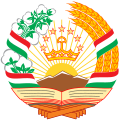

The following outline is provided as an overview of and topical guide to Tajikistan:
Contents
- General reference
- Geography of Tajikistan
- Environment of Tajikistan
- Regions of Tajikistan
- Demography of Tajikistan
- Government and politics of Tajikistan
- Branches of the government of Tajikistan
- Foreign relations of Tajikistan
- Law and order in Tajikistan
- Military of Tajikistan
- Local government in Tajikistan
- History of Tajikistan
- Culture of Tajikistan
- Art in Tajikistan
- Sports in Tajikistan
- Economy and infrastructure of Tajikistan
- Education in Tajikistan
- Health in Tajikistan
- See also
- References
- External links
Tajikistan – mountainous, landlocked, sovereign country located in Central Asia. [1] It borders Afghanistan to the south, Uzbekistan to the west, Kyrgyzstan to the north, and China to the east. Most of Tajikistan's population belongs to the Tajik ethnic group, who share culture and history with the Persian peoples and speak the Tajik language, a modern variety of Persian. Once part of the Samanid Empire, Tajikistan became a constituent republic of the Soviet Union in the 20th century, known as the Tajik Soviet Socialist Republic (Tajik SSR).
After independence, Tajikistan suffered from a devastating civil war which lasted from 1992 to 1997. Since the end of the war, newly established political stability and foreign aid have allowed the country's economy to grow. Its natural resources such as cotton and aluminium have contributed greatly to this steady improvement, although observers have characterized the country as having few natural resources besides hydroelectric power and its strategic location. [2]






